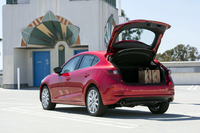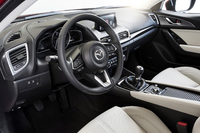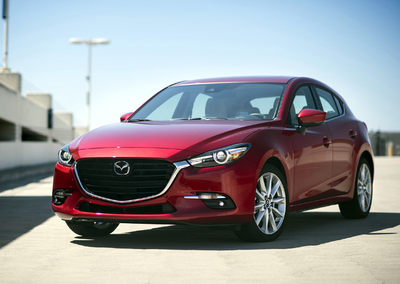2017 Mazda Mazda3 5-Door Grand Touring Review by Carey Russ
The Mazda3 Hatchback Remains at the Head of its Class
DRIVING DOWN THE ROAD WITH CAREY RUSS
• SEE ALSO: Mazda Research and Buyers Guide
 |
Mazda's popular Mazda3 compact hatchback and sedan get a mid-product cycle freshening for 2017, with subtle changes to the exterior, interior, and chassis, more standard and optional safety technology, a nd the usual changes to color choices. The previous “i” and “s” model designations denoting engine choice — 2.0-liter, 155 horsepower and 2.5-liter 184-hp respectively — are history. If both engines are available in a model, examples with the 2.5 are called “2.5”, while those with the 2.0 are unadorned.
As is the case with some competitors, the five-door (four passenger doors plus the hatch) hatchback is positioned upscale to the sedan. Models are Sport (2.0 engine), Touring (both engines), and Grand Touring (2.5 only). Touring models all have a six-speed multi-mode automatic as their only transmission choice, while Sport and Grand Touring versions can also be had with a six-speed manual. Most manufacturers who offer a stick today offer it only in the base model. Not Mazda. But then, Mazda is definitely not “most manufacturers”…
Two philosophical statements distinguish Mazda from other automakers. First is the company’s “KODO Soul of Motion” physical design language, which give the entire product lineup a distinctive and easily-recognizable look. And a good look at that. Second is “Jinba Ittai”, which translates to “horse and rider as one”. Meaning that the vehicle must be an extension of the driver, and do what the driver wants it to do, in a manner that makes it feel like an extension of the driver. This would seem to apply more to sports cars, or high-performance sportbikes, that to family sedans or hatchbacks — but it’s every bit as much in the Mazda3’s character as it is in that of the MX-5 Miata.
This week’s test car is a well-equipped Mazda3 Grand Touring. I was expecting an automatic as that’s what’s most popular, but was pleasantly surprised when I saw the stick in the console. Mazda has followed the trend to electronic parking brakes, ostensibly to free up console space. The combination of a manual transmission and on/off parking brake is usually unpleasant and unhealthy for the clutch. Credit Mazda for adding a “hill-hold” function to reduce chances of rolling backwards on a hill. It almost makes up for the electronic brake. (more technology to fix technology…) My week was a bit unusual, with a 120-mile, mostly-highway round trip for the holiday. That particular highway was never straight or level for very long, and I escaped to side roads as much as possible because I was in a Mazda3, made for those roads. But even stop-and-go traffic was tolerable, and not at all hard to deal with. And I got home with a 33+ mpg fuel economy average — right on the EPA rating but in conditions much tougher than the EPA simulation. I wasn’t babying the car or hypermiling, either. Good performance, a great driving experience, and commendable fuel economy… what’s not to like here? Then add the convenience and versatility of a five-door hatchback and you have the Mazda3.
APPEARANCE: Differences between a 2017 and 2016 Mazda3 hatch are not readily apparent. Fenders, doors, and the roof are all the same, but the front and rear fascias are just a little different. In front, the grille, headlights, foglamp mounts, and lower intake have been subtly reshaped. The winged corporate logo moves downward a few inches, and the chrome trim around the lower part of the grille, extending into the headlights, is a bit thicker. Differences at the rear are even less, with LED taillights in some versions, including this one, and revised reflectors the “major” changes.
 |
COMFORT: “Upscale but not ostentatious” best describes the Mazda3’s interior design and appointment, especially in premium Grand Touring trim. Unlike other Japanese manufacturers, who seem to favor complexity for complexity, Mazda is Teutonically simple. Materials look from a class or two above as well. The major changes for 2017 are replacement of the parking brake lever by the console with the electric parking brake switch, allowing a new console design with a roll-top cover over the cupholders and more storage space, and a revised steering wheel. Less apparently, color schemes have changed a bit. The Grand Touring’s leather seats now have perforations in the seating area, and here three-level cushion heat. The driver’s is power-adjustable. A heated steering wheel is new, and most welcome on a cool Fall morning. The steering wheel adjusts manually for tilt and reach and has audio, information, phone, and cruise system controls. Instruments are easily visible, and all controls well-placed. A rearview camera helps when backing. Front seat comfort is very good. Period, not merely “for the class”. The rear seat is spacious for the car's size, and contoured for outboard passengers. Cargo space with the 60/40 split rear seatback up is good, and even better with it down, plus easy access via the rear doors. There is a space-saver spare under the cargo area, not a can of sealant.
SAFETY: The Mazda3's structure protects passengers with all of the currently required safety features and technology, including multiple air bags, safety cell and crumple zones, dynamic stability control, a backup camera, and a tire-pressure monitoring system. Brakes are four-wheel disc, with antilock, electronic brake-force distribution, and brake assist. At Grand Touring level a blind-spot monitoring system with cross-traffic alert is standard. Technologies including lane-departure warning and lane-keep assist systems and radar-based cruise control are offered, and were on this car. Previous model years have gotten a five-star safety rating from NHTSA and Top Safety Pick+ from the IIHS.
RIDE AND HANDLING: Mazda's Skyactiv technology is a systems approach to increasing efficiency and safety. Part of increasing efficiency is controlling weight. Less weight requires less power to move, which means less fuel used and lower emissions, a win-win situation if the engineering and construction can be done correctly. Here, they are. The Mazda3 is well-balanced and a pleasure to drive. A lightweight but rigid unibody structure that still provides crashworthiness is the key. To that add a compliant but perfectly-tuned MacPherson/multilink suspension that provides comfort without isolation on the road and is still completely capable at higher speeds. It's not seriously sport-oriented like the late Mazdaspeed version of the previous generation, but it's quite capable on the road. Or at higher speeds on the track, as I’ve discovered with previous examples. Electrically-assisted steering need not be video game-controller numb, see here for details. New this year is “G-Vectoring Control” (GVC). It uses sensors and computer controls to decrease engine torque ever so slightly when initiating a cornering maneuver in order to improve stability and reduce the need for steering corrections. Mazda has said that the soul of an MX-5 Miata lurks inside every one of their cars, and that's true. And here it’s not far below the surface.
PERFORMANCE: Both engines used in the Mazda3 share basic architecture and engineering -- aluminum alloy block and head, dual overhead cams activating two intake and exhaust valves per cylinder with variable cam phasing and direct fuel injection. That allows a high 13:1 compression ratio, for maximum extraction of energy from a lean fuel/air mixture. Careful engineering allows that fuel to be unleaded regular. The result is fine performance and fuel efficiency. Compared to the 2.0-liter, the 2.5 develops its maximum torque and horsepower at lower revs. Maximum horsepower is 184 at 5700 rpm; maximum torque is 185 lb-ft at a low 3250 rpm. Which means a healthy midrange, just what you want for easy driving, and less need for shifting. There is no reason to get acquainted with the rev limiter. The manual transmission’s shift linkage is smooth and precise, and a light clutch pedal and good pedal design add even more pleasure to the driving experience. The stick is more involving and so more fun for those of us with that preference, but thanks to the engine’s strong midrange torque, the automatic has little if any negative effect on performance or economy and is less stress in traffic.
CONCLUSIONS: Careful small improvements keep the Mazda3 hatchback at the front of its class, and competitive with more-expensive European cars as well.
SPECIFICATIONS
2017 Mazda Mazda3 5-Door Grand Touring
Base Price $ 23,895
Price As Tested $ 27,730
Engine Type aluminum alloy 16-valve DOHC inline 4-cylinder with direct fuel injection and variable cam phasing
Engine Size 2.5 liters / 152 cu. in.
Horsepower 184 @ 5700 rpm
Torque (lb-ft) 185 @ 3250 rpm
Transmission 6-speed manual
Wheelbase / Length 106.3 in. / 175.6 in.
Curb Weight 3028 lbs.
Pounds Per Horsepower 16.5
Fuel Capacity 13.2 gal.
Fuel Requirement 87 octane unleaded regular gasoline
Tires 215/45R18 89W m+s Dunlop Sport SP 5000
Brakes, front/rear vented disc / solid disc, ABS, EBD, BA standard
Suspension, front/rear independent MacPherson strut / independent multilink
Drivetrain transverse front engine, front-wheel drive
PERFORMANCE
EPA Fuel Economy - miles per gallon city / highway / observed 25 / 33 / 31
0 to 60 mph 7.5 sec
OPTIONS AND CHARGES
Cargo Mat $ 75
Rear Bumper Guard $ 100
Door and Sill Trim Scuff Plates $ 125
Premium EQ Package — includes: auto on/off LED headlights, LED daytime running lights, LED combination taillights, adaptive front lighting system, Mazda navigation system, heated steering wheel $ 1,600
i-Active Safety Package — includes: high-beam control, lane-departure warning system, lane-keep assist, smart brake support, Mazda radar cruise control, traffic sign recognition $ 1,100
Destination Charge $ 835



